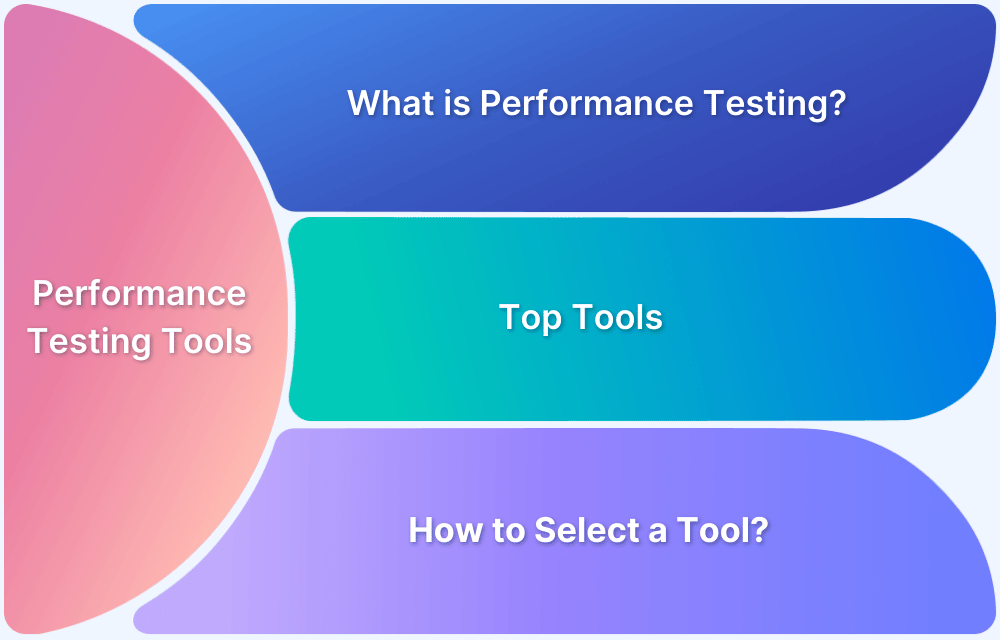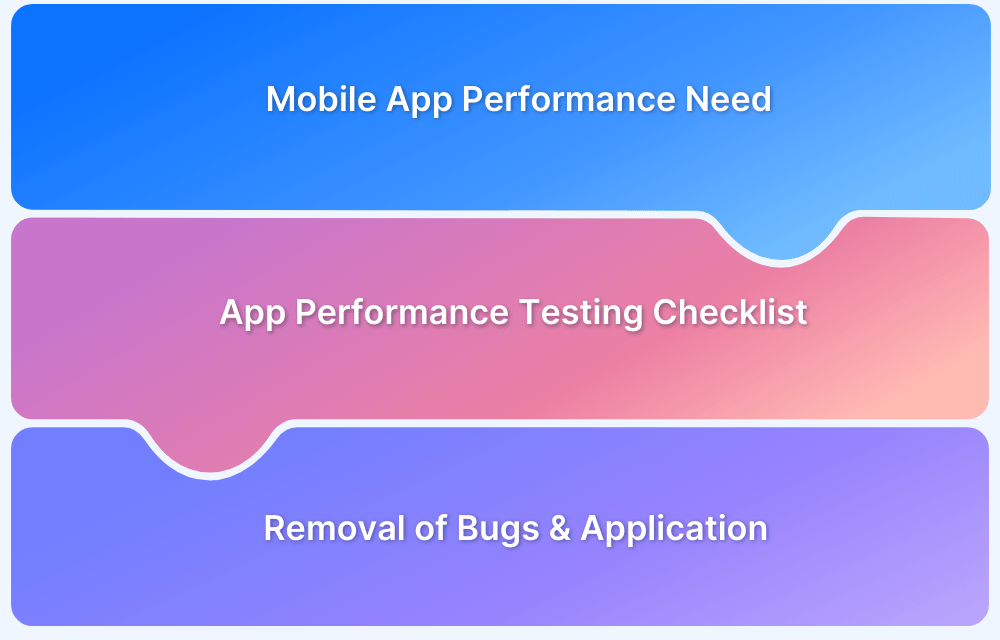Performance testing assesses how a website or application performs under certain conditions. It focuses on key factors like responsiveness, stability, speed, and reliability to ensure the system runs smoothly.
Performance testing is important because it ensures fast load times, reduces the risk of crashes, and identifies potential issues with scalability. Releasing an application without testing could damage a brand’s credibility and reputation.
This article covers the fundamentals of performance testing, including its types, tools, examples, and more.
What is Performance Testing?
Performance testing is a software testing method used to assess how well an application functions under expected workloads, network conditions, and data volumes.
Its primary objective is to ensure the application is fast, stable, scalable, and responsive across environments.
For instance, before launching a gaming app, performance testing helps verify that it loads quickly, renders visuals correctly, handles multiplayer interactions smoothly, and runs efficiently across devices.
Importance of Performance Testing
Performance testing is essential to ensure your website or application delivers a smooth, reliable experience for users. Here are some benefits of performance testing.
- Identifies performance bottlenecks before they affect users.
- Ensures fast load times and optimal user experience, even under heavy traffic.
- Helps improve system scalability for future growth.
- Detects potential points of failure and reduces downtime risks.
- Validates the stability and reliability of your system across different environments and conditions.
Performance Testing Example Scenarios
Assume an example of testing an e-commerce app’s performance. It is important to evaluate how well it handles peak traffic and user demands.
The below table demonstrates an example of how load, stress, and other performance testing types ensure stability and optimize user experience.
| Aspect | Example Scenario |
|---|---|
| Objective | Assess the e-commerce app’s performance under various shopping peaks and device types. |
| Load Testing | Simulate 8,000 users browsing and adding items to carts simultaneously. |
| Stress Testing | Apply a surge with 15,000 users to test stability during a flash sale event. |
| Scalability Testing | Incrementally add virtual users to gauge server load capacity and response times. |
| Real User Monitoring | Track user actions during new feature releases to spot any performance drops. |
| Performance Metrics | Measure page load times, checkout speed, API call response, CPU/memory usage, and bandwidth. |
| Reporting and Analysis | Create performance reports with user insights and improvement recommendations for future sales. |
Read More: Guide to UI Performance Testing
When should you conduct Performance Testing?
Performance testing should be conducted at various stages of the software development life cycle.
- Before major releases or significant updates
- When adding new features that could affect performance
- Regularly in environments that mirror production
- Prior to anticipated high traffic or user growth
- Early in development to catch potential issues quickly
Key Metrics to Measure in Performance Testing
Performance testing focuses on evaluating system behavior under various conditions, and its success relies on tracking specific metrics or KPIs. These metrics help identify performance bottlenecks, assess readiness for production, and highlight areas for optimization.
Core Metrics to Monitor:
- Response Time: Time taken for the system to respond to a user request.
- Throughput: Number of transactions or data units processed per second.
- Resource Utilization: Usage levels of CPU, memory, disk, and network.
- Scalability: System’s ability to maintain performance as user load increases.
- Concurrent Users: Maximum number of users supported simultaneously.
- Error Rate: Frequency of failed transactions or system errors.
- Peak Performance: Highest performance level under maximum load.
- Latency: Delay between user request and system response initiation.
- Bandwidth: Data transferred per second across the network.
- CPU Interrupts per Second: Number of hardware interrupts during processing.
Types of Performance Testing
Performance testing focuses on evaluating how well an application performs under various conditions.
Below are the core types of performance testing used to assess system speed, stability, scalability, and responsiveness:
1. Load Testing: Simulates expected user traffic to determine how the system handles normal usage. It helps identify bottlenecks and evaluate performance metrics like response time and throughput.
2. Stress Testing: Pushes the system beyond its normal load capacity to assess its breaking point. This helps identify how the system behaves under extreme traffic and how gracefully it recovers from failure.
3. Spike Testing: Tests the system’s ability to handle sudden and sharp increases in traffic. It checks whether the application can manage abrupt load spikes without crashing or slowing down drastically.
4. Soak Testing/Endurance Testing: Examines system performance over an extended period under a steady load. It helps uncover memory leaks, performance degradation, and other long-term reliability issues.
5. Volume Testing: Focuses on how the system performs when handling large volumes of data. It’s used to identify performance issues related to database size, file uploads, or data processing at scale.
6. Scalability Testing: Assesses the application’s ability to scale up or down based on user demand. It checks whether performance remains consistent as the workload increases.
Difference between Load Testing and Performance Testing
While often used interchangeably, load testing and performance testing are not the same. Performance testing broadly evaluates how a system behaves under different conditions, while load testing specifically measures performance under expected user traffic.
Essentially, load testing is a subset of performance testing, alongside others like stress, spike, soak, and unit test, each of which targeting specific performance concerns.
Performance Testing Process
Follow these streamlined steps to ensure your software performs reliably under real-world conditions:
1. Set Up the Right Test Environment
Use a test setup that mirrors your production environment as closely as possible.
For accurate results, test on real devices and browsers using a real device cloud like BrowserStack Automate. It enables testing across 3500+ device-browser-OS combinations, simulating real user conditions like low network, battery levels, or location changes.
2. Define Performance Benchmarks
Establish clear success criteria like response time, throughput, resource usage, and error rates.
Use project requirements to define measurable goals and thresholds.
Read More: Essential Metrics for the QA Process
3. Design Test Scenarios
Create test cases that reflect real user behavior. Include varied usage patterns and peak load conditions. Automate where possible to speed up execution and minimize human error.
4. Prepare Tools & Test Environment
Configure all necessary tools, integrations, and test data. Ensure version control and environment variables are properly set up for consistency.
5. Run Tests
Execute test suites under controlled conditions. Use parallel testing to reduce execution time while maintaining accuracy.
6. Analyze, Debug & Re-Test
Review key metrics, identify bottlenecks, and log issues. Once fixes are made, re-run the tests to validate improvements and ensure the system is ready for production.
Top Performance Testing Tools
Choosing the right performance testing tool is key to building fast, scalable, and reliable software.
Here are some of the best performance testing tools developers and QA teams rely on:
- BrowserStack App Performance: Test mobile apps on real devices to measure speed, responsiveness, and stability across real-world conditions.
- Apache JMeter: Open-source tool for load testing web apps and APIs.
- Gatling: Scalable, developer-friendly tool using asynchronous I/O for web app testing.
- LoadRunner: Enterprise-grade load testing for various application types.
- BlazeMeter: Cloud-based platform supporting JMeter, Gatling, and Selenium.
- Locust: Python-based tool for user load simulation on websites.
- K6: Scriptable load testing focused on APIs and modern web apps.
- Apache Bench: Simple, command-line benchmarking tool for HTTP servers.
- NeoLoad: Advanced enterprise tool for load testing complex systems.
- Tsung: Distributed tool for stress testing web and protocol-based systems.
- WebLOAD: Enterprise solution with support for complex load scenarios.
- Selenium: Widely used for functional and basic performance testing of web apps.
- LoadNinja: Cloud-based tool using real browsers for precise load tests.
- Dynatrace: AI-powered monitoring for real-time performance insights.
- Artillery: Lightweight CLI tool for testing HTTP services and APIs.
- New Relic: Full-stack observability for app and infrastructure monitoring.
- AppDynamics: APM tool for tracking end-to-end performance metrics.
- Sitespeed.io: Open-source tool for analyzing front-end performance.
- Puppeteer WebPerf: Chrome-based automation tool for performance benchmarks.
- Siege: Command-line tool to test server response under concurrent user traffic.
Importance of Testing on Real Devices with BrowserStack
Accurate performance testing requires real-world conditions. BrowserStack Automate enables developers and QA teams to test across 3500+ real devices and browsers for reliable results.
Key benefits of testing on Real Devices with BrowserStack Automate
- Run automated Selenium tests on real devices and OS versions
- Simulate real-world scenarios like network conditions, geolocation, screen sizes
- Identify performance issues early with detailed logs and debugging
- Scale testing with parallel execution and CI/CD integrations
Performance Testing vs Continuous Performance Testing
Conventional performance testing checks an app’s performance at certain specific points. On the other hand, continuous performance testing incorporates checks at each and every stage of development. This ensures ongoing monitoring and optimization.
Here is a quick comparison:
| Aspect | Performance Testing | Continuous Performance Testing |
|---|---|---|
| Purpose | It evaluates app performance at specific stages | Continuously monitors performance throughout the development lifecycle |
| Frequency | Conducted periodically, typically before major releases | Ongoing, integrated into CI/CD pipelines |
| Scope | Focuses on particular scenarios or stages | Covers all stages, from development to production |
| Tools | Often uses standalone tools | Relies on automated tools and monitoring solutions |
| Goal | Identifies performance issues before release | Ensures consistent performance over time, catching regressions early |
Performance Engineering vs Performance Testing
Here are the main differences between performance testing and performance engineering.
| Aspect | Performance Testing | Performance Engineering |
|---|---|---|
| Focus | Identifies and fixes performance issues through testing | Proactively designs and optimizes systems for high-performance |
| Approach | Reactive and assesses performance at specific stages | Holistic, integrated throughout the development lifecycle |
| Scope | Primarily tests speed, scalability, and stability | Includes architecture, coding, testing, and monitoring |
| Tools | Uses testing tools for simulations | Involves a wide range of tools for design, development, and testing |
| Goal | Ensures the app meets performance criteria before release | Builds systems to perform optimally under expected conditions |
Challenges in Performance Testing
Here are some common challenges in performance testing:
- Realistic Environment Setup: It’s often costly and complex to fully recreate production conditions for testing.
- Crafting Test Scenarios: Creating the exact user scenarios and load patterns require precise planning and expertise.
- Resource Demands: Performance tests require high investments in hardware, software, and time.
- Data Consistency: Ensuring consistent and relevant data across various tests can be challenging.
- Tool Integration: Aligning testing tools with diverse tech stacks can bring compatibility challenges.
- Result Analysis: It takes experience to analyze complex data and pinpoint root causes effectively.
Best Practices for Performance Testing
Follow these best practices when running a system performance test:
- Start at Unit Test Level: Do not wait to run performance tests until the code reaches the integration stage. This is a DevOps-aligned practice, part of the Shift Left Testing approach. This reduces the chances of encountering errors in the latter stages.
- Remember that it is about the User: The intention of these tests is to create software that users can use effectively. For example, when running tests, don’t just focus on server response; think of why speed matters to the user. Before setting metrics, do some research on user expectations, behavior, attention spans, etc.
- Create Realistic Tests: Instead of overloading servers with thousands of users, simulate real-world traffic that includes a variety of devices, browsers, and operating systems.
Use tools like BrowserStack to test on actual device-browser combinations that match your audience. Also, start tests under existing load conditions, as real-world systems rarely operate from a zero-load state. - Set Clear, Measurable Goals: Define specific performance goals based on user expectations and business requirements. It includes response times, throughput, and acceptable error rates.
- Automate Where Possible: Make use of automation tools to run performance tests, especially in continuous integration and continuous delivery (CI/CD) pipelines.
- Monitor in Production: Use performance monitoring tools in the live environment to catch issues that might not appear in test environments. This ensures consistent performance.
- Analyze and Optimize: Continuously analyze test results and implement solutions to optimize, then re-test to confirm improvements.
- Prepare for Scalability: Test with different load levels to ensure the app can scale as needed, especially if user numbers are expected to grow rapidly.
Conclusion
Performance testing plays a critical role in ensuring that applications deliver speed, stability, and a seamless user experience under real-world conditions.
By accurately simulating user load and traffic, teams can identify bottlenecks early and optimize system performance before release.
Testing on real devices enhances reliability, offering insights that emulators or virtual environments often miss. For teams aiming to maintain high-quality standards, integrating performance testing into the development lifecycle is crucial.






